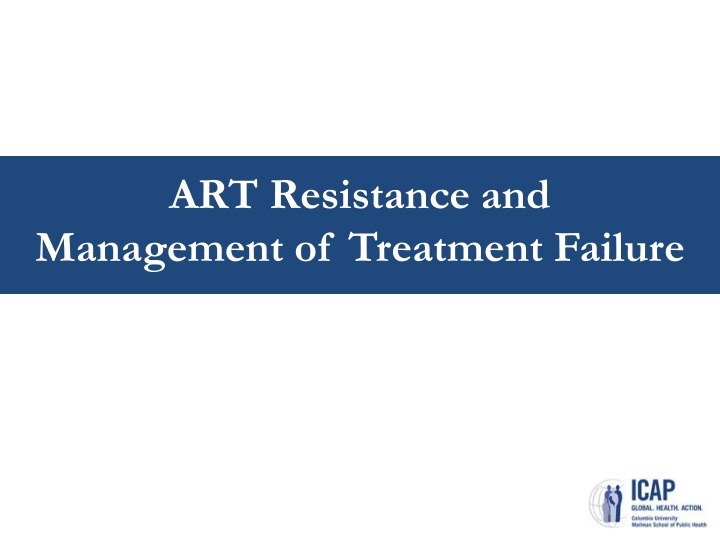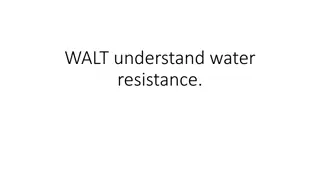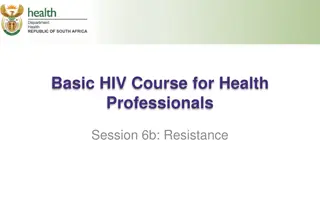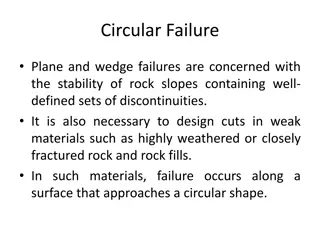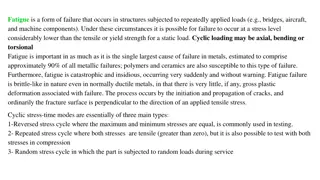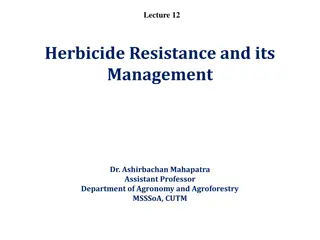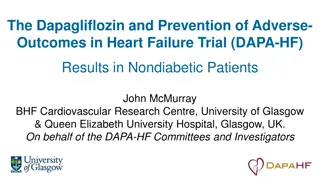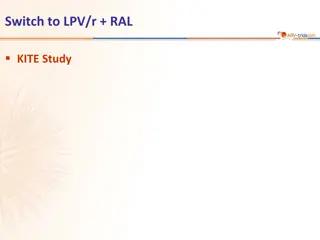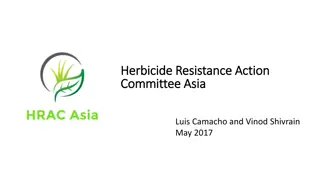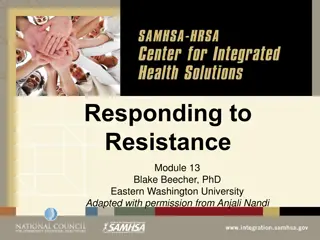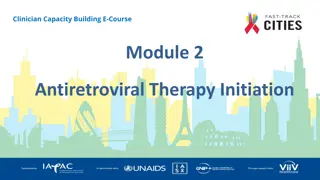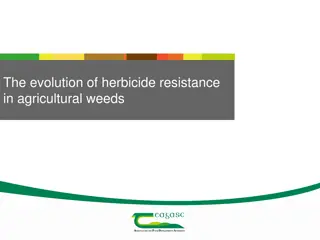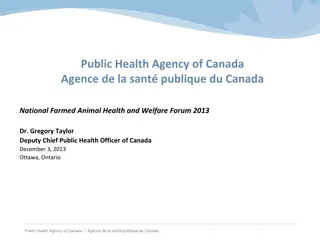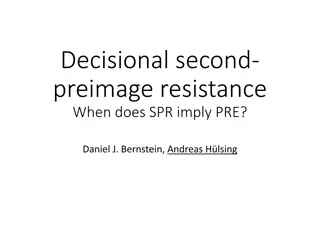ART Resistance and Management of Treatment Failure
This content delves into the strategic approach to managing treatment failure in ART, emphasizing when to switch to a second-line regimen for better clinical outcomes, prevention of drug resistance, and decreased transmission risks. Understanding preferred second-line regimens, drug resistance mutations, and characteristics of common drugs used is crucial for effective management.
Download Presentation

Please find below an Image/Link to download the presentation.
The content on the website is provided AS IS for your information and personal use only. It may not be sold, licensed, or shared on other websites without obtaining consent from the author.If you encounter any issues during the download, it is possible that the publisher has removed the file from their server.
You are allowed to download the files provided on this website for personal or commercial use, subject to the condition that they are used lawfully. All files are the property of their respective owners.
The content on the website is provided AS IS for your information and personal use only. It may not be sold, licensed, or shared on other websites without obtaining consent from the author.
E N D
Presentation Transcript
ART Resistance and Management of Treatment Failure
Learning Objectives Understand when to switch to a second-line regimen Know preferred second-line regimens for adults (including pregnant and breastfeeding women), adolescents, and children Describe common drug resistance mutations and how they influence choosing a second-line regimen Be familiar with characteristics of the drugs commonly used in second-line regimens
Management of Treatment Failure: When to Switch to Second Line? Improveclinical outcomes Prevent drug resistance Decrease riskof transmission Avoid unnecessary switches
Management of Treatment Failure: When to Switch to Second Line? Not Too Late Not Too Soon The longer an individual is maintained on a failing regimen, the longer there is ongoing viral replication & immune damage Worseclinical outcomes Greater opportunity for drug resistance to develop [more mutations, resistance to more medications] Increased riskof transmission Patients should report good adherence, and assessment by health care worker should confirm adherence Suboptimal adherence may lead to failure ofthe new ART regimen. Address adherencefirst. Sufficient time to achieve viral suppression must be provided prior to viral load testing
Management of Treatment Failure: Switching to Second Line Adherence Assessmentand Intervention Improved Adherence Reported and Detected Treatment Failure Confirmed(Repeat Viral Loadhigh) Need to consider: Reproductive issues Drug resistance Comorbidities Switch to SecondLine Regimen
Management of Treatment Failure: When to Switch to Second Line? In general, failure to achieve a low viral load 1-3 months after improved adherence suggests that the virus has acquired resistance to the ART regimen follow country guidelines regarding the cutoff for low However, it may be useful to consider the extent of viral load reduction by log scale. A reduction of >1 log per month with good adherence may suggest viral load suppression is achievable on current regimen with additional time. Should continue the current regimen and repeat viral load in another few months if virus is not yet suppressed
ARV Characteristics Tang and Shafer, Drugs2012
ARV Characteristics (2) Tang and Shafer, Drugs2012
ARV Characteristics (3) K103N Y181C K65R Thymidine analogue mutations (TAMs) M184V Tang and Shafer, Drugs2012
ARV Characteristics (4) K103N Y181C K65R Thymidine analogue mutations (TAMs) M184V Tang and Shafer, Drugs2012
The risk of continuing a failing regimen.. Early in virologic failure, the virus may have acquired resistance to only one medication in the regimen The longer that a patient remains on a regimen that is not fully suppressing viral replication, the greater the risk that additional resistance mutations will be acquired and that the virus will become resistant to additional drugs in the ART regimen
Prevalence of Resistance Mutations by Frequency of VL Monitoring Gupta et al., Lancet Infect Dis,2009
Failing regimens.TDF/3TC/NNRTI Lancet Infect Dis,2016
Failing regimens.TDF/3TC/NNRTI (2) This has been a recommended 1st lineART The TenoRes Study Group looked at resistance mutations from 1926 patients from 36 countries who failed such regimens between 1998-2015 There were marked differences in the frequency of multidrug resistance mutations (especially to TDF) based on geographic location of thepatient Likely due to lower frequency of VL monitoring and longer period on a failing regimen in LMIC Lancet Infect Dis,2016
Failing a first line regimen.. TDF/3TC/NNRTI All agents in this regimen have a low genetic barrier to resistance All compromised by a single amino acid change In the TenoRes study, risk for resistance to TDF was related to the regimen: NVP > EFV 3TC > FTC
Common Resistance Mutations Low Barrierto Resistance 3TC/FTC M184V Not Quite as but Still Low Barrier to Resistance AZT and d4T thymidineanalogous mutations (TAM), acquired over time TDF K65R NRTI s NNRTI s NVP and EFV Y181C and K103N Tang and Shafer, Drugs2012
M184V Selected by and causes high level resistance to 3TC and FTC Reduces viral fitness or replicative capacity Confers increased susceptibility to AZT and TDF Tang and Shafer, Drugs2012
Y181C and K103N Y181C selected by and causes high level resistance to NVP Also causes resistance to EFV K103N selected by NVP or EFV and causes high level resistance to both Tang and Shafer, Drugs 2012; Stanford University, HIV Drug ResistanceDatabase
K65R Selected primarily by TDF, but can sometimes emerge with d4T, ABC, ddI Causes intermediate resistance to TDF, ABC, ddI, 3TC/FTC and low-level resistance to d4T Confers increased susceptibility to AZT Tang and Shafer, Drugs2012
TAMs TAMs include M41L, D67N, K70R, L210W, T215F/Y, and K219Q/E Selected by AZT and d4T Confer cross-resistance to multiple NRTI s Mutations emerge over time in two distinct patterns, but can overlap Tang and Shafer, Drugs 2012; Marcelin et al., Journal Medical Virology 2004
Integrase Inhibitors (INSTIs) Raltegravir (RAL)and elvitegravir (EVG) had a lower barrier to resistance Dolutegravir (DTG) has a higher barrier There were no failures due to resistance in the dolutegravir pre-marketing randomized control trials RAL: 400 mg tab, 100mg scored chewable tab, 25 mg chewable tab, granules (50mg) for oral suspension DTG: 50, 25, 10 mg tabs Minimal drug interactions Few side effects, but hypersensitivity reaction or insomnia and dizziness can be seen
Dolutegravir as 1st-Line Advantages over Efavirenz or Nevirapine lower potential for drug interactions a shorter time to viral suppression a higher genetic barrier to drug resistance long half-life Small size of tablets (easier to swallow) Activity against HIV-2 infection, which is naturally resistant to EFV availability as a generic fixed-dose formulation potential price reductions applicable to most low- and middle-income countries
Q148H/K/R/N There are several possible amino acid substitutions at position 148 of the integrase gene that lead to INSTI resistance These rarely develop when a potent INSTI is used in a regimen that contains 2 or 3 active drugs More common when a low potency 1st generations INSTI (RAL or EVG) is used first, then the patient is later switched
Second-line Therapy 2nd line therapy should consider what medications the patient has taken previously and what resistance their virus has likely acquired
WHO Recommendations: Second Line Regimens (2) Optimization of the NRTI backbone Consider genotyping Empiric changes - use AZT/3TC if TDF/3TC was in the prior regimen and vice versa Dolutegravir with at least one active NRTI (predicted by genotypic testing) is generally an adequate regimen
Second Line Regimens in Country: Adults Fill in according to national guidelines
Second Line Regimens in Country: Children Fill in according to national guidelines
Neural Tube Defects & DTG Prevalence in Tsepamo study is 5 in 1683 DTG exposures at the time of conception Three times higher than in women not on DTG 0.30% (1 in 1000 exposures during conception) DTG appears to be safe after closure of the neural tube (~ 8 weeks of gestation)
Protease Inhibitors Acceptable for adolescents and women of childbearing potential High barrier to resistance DRV/r highest barrier to resistance ATV/r and LPV/r available in heat stable fixed dose combinations Drug interactions, including TB drugs GI side effects (including nausea and diarrhea) common Tang and Shafer, Drugs 2012; WHO Guidelines, 2013
Third Line Regimens Include drugs without cross-resistance to previously used regimens Integrase inhibitors, second generation PIs (darunavir/r) and NNRTIs (etravirine) Customized to what is available in country Genotyping can be useful, but mutations present in cDNA but not replicating can be missed Most useful for current or recent ART
Common Mutations and Effect on Regimen Selection Component of OriginalRegimen Common Mutations Effects on Future Regimens 3TC/FTC M184V Maintain because likely benefit despite resistance due to fitness cost and increased susceptibility to AZT and TDF EFV or NVP K103N, Y181C,others Likely cross resistance to both EFV and NVP Integrase or Protease Inhibitor TDF K65R Switch to AZT, usually still active AZT or d4T TAMs If multiple TAMs limited NRTI activity, but if early benefit from TDF. Alternate is INSTI/PI with NRTIs
Third Line Regimens in Country: Adults Fill in according to national guidelines
Third Line Regimens in Country: Children Fill in according to national guidelines
Summary Avoid premature or delayed switching of ART When switching for treatment failure avoid single agent switches Selection of 2ndand 3rdregimens must take into account common resistance mutations that arise from prior regimens.
Case 1 47 year old woman on TDF/FTC/EFV for 2 years who has had periods of poor adherence. Routine VL monitoring becomes available, her results return at 4,500 copies/ml. You call her to come into the clinic and adherence assessment reveals fair adherence. Over the course of 5 monthly enhanced adherence sessions, she achieves 3 months of good adherence and repeat VL is 3,300 copies/ml.
Case 1 (2) What is your assessment? What are next steps?
Case 2 (3) 28 year old man newly diagnosed with HIV in the OPD. Started on TDF/FTC/EFV and first VL returns at 890,000 copies/ml. Enhanced adherence sessions are conducted and he achieves good adherence quickly. After three months of reported good adherence, repeat VL is 3,700.
Case 2 (4) What is your assessment? What are next steps?
